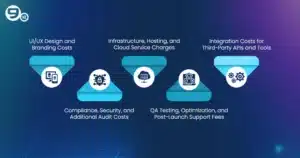Whether you are looking to develop logistics software or want to level up your sales with the right integration, the foremost factors that cross your mind would be development cost. With the evolution of the technological era, AI and ML are transforming how software is scaled, deployed, and built. Utilizing intelligent tech support enables automation for complex workflows, enhances decision-making, and mitigates inefficiencies.
However, the software landscape in Texas is highly competitive due to the presence of innovation-led development companies, tech giants, and experienced developers. The United States is attracting a surge in demand for cloud-based software due to remote collaboration and accessibility, which will expand the market value to reach $462 billion by 2030.
So, companies are comparing software development cost in Texas depending on the project complexities, timelines, and technology stack. Here is the guide blog, where you can find all relevant details in one place. It will help to finalise the overall budget for the next software development project and ensure its quality deployment by discussing timelines, average rates, and hidden charges.
What Determines Software Development Cost in Texas?
During the planning stage of software development in Texas, multiple strategic and technical factors should be considered that directly influence costs. Although every software development company in Texas prefers to have its own pricing models, Texas has a competitive demand for the service that unlocks a range of price differences. Whether you choose to set up an in-house development team or outsource through an offshore provider, the factor that varies to impact the overall cost estimation.
Start Your Software Development in Texas
Talk to our Experts
Request A Free Quote
Here are the following factors that determine the software development cost in Texas:
Project Size and Feature Complexity
One of the significant cost drivers is the scale and complexity of projects, particularly in terms of features. Basic software with minimalist features will take less time and cost, and will be easy to deploy without any significant issues. On the other hand, multi-feature software with advanced functionalities, such as AI upgrades or real-time dashboards, requires more expertise, expensive technology, and more complex features, which can raise the overall budget.
Type of Software (Web, Mobile, Enterprise, SaaS)
Software development cost in Texas significantly vary for the types of software and their underlying technical specifications, along with resource requirements. Web applications or mobile-based software are faster to build and cost-effective with fewer complexities. While developing SaaS-based software and enterprise-level products built on complex workflows and architectures, security layers require combining different methodologies and increasing the pricing.
Industry Requirements and Compliance Standards
Texas has been the center hub for the United States, with diverse software demand across various industries, including logistics, retail, and finance. Some industries have strict regulatory compliance and strict controls for data encryption, authentication protocols, and audit trails. All these factors contribute to additional development time and impact the total project costs.
Development Methodologies
Software development follows various methodologies, such as agile development, lean development, or waterfall development, based on the requirements, which in turn influences pricing. Under the agile approach, tech companies in Texas work in shorter sprints for faster delivery and reduce development costs by eliminating frequent iterations. Waterfall development follows more predictable and moderate costs, whereas DevOps, which focuses on automation, CI/CD pipelines, requires cloud expertise, resulting in higher setup costs.
Average Software Development Rates in Texas
Once the company aligns with considerable factors that affect their overall software development budget, they compare average rates in Texas to build the best software within the estimated costs. These rates can vary depending on hiring models and specific locations in Texas to finalize the end software development cost in Texas:
Hourly Rates of Texas Developers (Junior, Mid, Senior)
| Experience Level | Typical Hourly Rate in Texas (2025) |
|---|---|
| Junior Developer | $50 – $80 / hr |
| Mid-Level Developer | $80 – $120 / hr |
| Senior Developer | $120 – $180 / hr |
However, these development rates for developers are subject to change based on their industry experience, skills, domain, and project complexity.
Cost Differences Between Austin, Dallas, Houston, and San Antonio
| City | Approximate Hourly Rate Range | Why the Rates Differ |
|---|---|---|
| Austin | $75 – $150/hr (for local agencies) | Austin is a central tech hub, known as “Silicon Hills,” with diverse demand for skilled developers that drives up agency and senior dev rates. |
| Dallas | $40 – $150/hr depending on experience | Balanced mix of enterprise clients and startups; slightly lower senior rates compared to Austin |
| Houston | ~$80 – $150/hr for development work (comparable to broader Texas average) | Houston’s diverse economy leads to variable demand. |
| San Antonio | Slightly lower than Austin and Houston, particularly for design/web-dev work (e.g., ~$60–$140/hr) | The growing tech space is less saturated than Austin, with cost benefits stemming from lower demand and the presence of big agencies. |
Freelancers Vs In-House vs Agency Rates in Texas
| Hiring Model | Average Hourly Rate | Ideal For |
|---|---|---|
| Freelancers | $40 – $90/hr | Small tasks, short-term projects, MVPs |
| In-House Developers | $65 – $150/hr | Long-term products, continuous development |
| Texas Agencies | $80 – $200/hr | Full-scale projects, end-to-end development, managed teams |
| San Antonio | Slightly lower than Austin and Houston, particularly for design/web-dev work (e.g., ~$60–$140/hr) | The growing tech space is less saturated than Austin, with cost benefits stemming from lower demand and the presence of big agencies. |
Cost Breakdown by Type of Software Project
Software development projects involve complex considerations, including team size, feature integration, technology stack, and delivery timelines. The overall budget is allocated for designing, developing, testing, and managing the project. Therefore, if your company is opting for small-scale projects, the cost structure will differ from that of big-scale projects, which involve more features and technicalities. It directly extends the scope of work and scalability requirements, which play a crucial role in determining the final costs.
Cost to Build an MVP or Prototype
Developing a minimum viable product is the most straightforward development approach, where the focus is on a specific function, and a fixed budget is allocated for the overall process. From minimal features to simple deployment, it is a cost-effective choice for experimental software to test the market.
Here is the cost breakdown to build the MPV or prototype for software:
| Step | Estimated Cost |
|---|---|
| Wireframing & UI | $2,000–$8,000 |
| Core Feature Development | $5,000–$25,000 |
| Basic Backend Setup | $2,000–$10,000 |
Cost of Custom Business Application Development
Custom development is highly demanded in the Texas software industry. As different business verticals capture their own customer bases, they encounter varied expectations and peak seasons. There is rarely a one-size-fits-all concept for custom software development; these products need customization to be built based on industry-specific needs.
Here is the cost breakdown to build the custom business application development:
| Step | Estimated Cost |
|---|---|
| Requirements Analysis | $5,000–$15,000 |
| UI/UX & Architecture | $8,000–$25,000 |
| Core Business Logic Development | $15,000–$70,000 |
| Integrations (ERP/CRM/APIs) | $10,000–$40,000 |
| QA, Security Testing | $5,000–$20,000 |
| Deployment & Training | $3,000–$10,000 |
| Total Cost | $40,000–$150,000+ |
Cost of Enterprise-Grade Digital Transformation Projects
Digital transformation projects focus on the modernisation of the entire technology used within the organisation through the use of cloud adoption and system migration. This adoption is designed to build a scalable platform that supports multiple departments and is backed by advanced architectures, complex integrations, and long-term development cycles.
Here is the cost breakdown to build the enterprise-level development projects:
| Step | Estimated Cost |
|---|---|
| System Audit & Strategy Planning | $20,000–$100,000 |
| UI/UX & Product Architecture | $25,000–$150,000 |
| Development (Large-Scale Modules) | $60,000–$400,000 |
| Cloud Migration & Integrations | $40,000–$200,000 |
| Security, Compliance, & Load Testing | $20,000–$100,000 |
| Multi-Stage Deployment | $10,000–$50,000 |
| Total Enterprise Cost | $150,000–$1M+ |
Hidden Charges You Should Know About
Do you think that your software development cost estimation is accurate? Well, it’s not, as there are considerable hidden charges that most development teams avoid. Opting for outsourcing and acquiring software from third-party vendors can affect the overall estimated budgets. Here is the list of hidden charges involved in the software development projects:
UI/UX Design and Branding Costs
Designing cost may be unpredictable for advanced feature software that follows complex prototyping, wireframes, dashboards, and real-time user flows. Although the development team allocates a budget for the UI/UX design, this amount varies depending on the number of revisions, the tools used for design, and any unexpected costs that may arise, such as those required to remove irrelevant elements from the designs.
Infrastructure, Hosting, and Cloud Service Charges
For optimal deployment and smooth functioning, the software requires a reliable environment with proper cloud storage, hosting, and infrastructure setup. It comprises various elements, such as load balancing, security layers, servers, and database complexities, which add to the ongoing costs. Additionally, as the user base expands, this enhances the infrastructure setup to meet traffic and scalability expectations. Additionally, there are hidden costs for monthly or yearly domain hosting and SSL certifications.
Integration Costs for Third-Party APIs and Tools
Nowadays, software is typically upgraded quarterly or yearly, with additional requirements that necessitate integrating third-party APIs and tools to enhance functionalities. It can extend development timelines, reduce setup costs, and optimize the overall development process. To avail these tools, there are underlying hidden charges involved, including licensing costs, user-based fees, and subscriptions.
Compliance, Security, and Additional Audit Costs
From eCommerce to the finance industry, it requires high security and compliance costs to meet the industry standards. In the initial planning stage, these cost elements might be overlooked due to a lack of updated data, cost fluctuations, and risk factors. These hidden charges include certifications, data encryptions, code audits, data handling regulations, and consultancy for software development.
QA Testing, Optimization, and Post-Launch Support Fees
The testing phase is unavoidable for successful software deployment; however, it is somewhat unpredictable to track the exact expenses. QA engineers and the development team assess multiple criteria, including load testing, functional testing, performance integrity, bug fixes, and additional hidden costs. Following the launch, it creates continuous demand for security patches, customer support, and feature enhancements.
How to Estimate Your Exact Software Development Cost?
Calculating the right software development cost in Texas doesn’t just involve comparing rates. If the company is aiming for advanced software, the process will undergo a series of steps beyond the basics to extract the final budget estimation. The development team follows a structured approach by estimating costs at each stage, comparing cost factors, and other relevant factors to avoid overspending on software projects.
Let’s review the step-by-step process for estimating software development costs:
Creating a Detailed Requirement Document
You can begin with initial planning to define the project scope, which outlines all the required features necessary for smooth functioning. Having a clear scope for development provides an accurate estimate and helps to avoid cost escalations. For better understanding, it is advisable to document these steps and user stories to provide more clarity on the subsequent process.
Importance of Feature Prioritization
Prioritizing the enlisted features in software implies a phased development approach that differentiates features according to usability, cost, and faster development. It supports the team in building the critical parts during the initial phase without scope for errors, while setting aside low-priority features for later implementation. Following this approach helps to structure costs, gather feedback, and lower the risk for feature failures.
Understanding Cost per Feature and Module
Now, the development team receives assurance for the required features, and they can list the cost per feature. Use this simple formula:
feature cost = Estimated hours * hourly rate.
For better tracking, these costs per feature can be categorized based on processes such as design, development, testing, and deployment, which ease predictability.
Development Methodologies and Tech Stack
Deciding on which programming language, cloud platforms, and frameworks will help to estimate the final development costs. Basic software may not require significant investment in expensive tools, whereas advanced software often necessitates the use of AI and blockchain to deploy a bug-free product. Also, choosing the right development model, whether freelancing or in-house development, beforehand can ease the cost estimate roadmap.
Request Quotation from Vendors
The next step is to list down all the vendors that align with your software development requirements and approach them for quotes on software development service in Texas. By comparing pricing, industry experiences, deliverables, timelines, support teams, and technical expertise, it is convenient to obtain the correct estimate and opt for the best company to trust for development projects.
Estimate on Hidden Charges
Assessing multiple elements of the hidden cost for software development helps finalize the budget. It enables the company to set aside a 10 to 20% buffer in the software development budget to fund unexpected changes, implement new ideas, and overcome technical issues.
How to Reduce Software Development Costs in Texas?
The simple formula companies in Texas aim to follow is to build the right product within a limited budget, without any compromise on quality. Is this possible? Yes, there are strategic ways to lessen the budget while maintaining software quality.
Choosing the Right Engagement Model (Fixed, Hourly, Dedicated Team)
All three models of software development involve hiring developers on an hourly basis, fixed budget methods, and hiring an in-house development team, which are cost-effective depending on the project’s scale, timeline, and feature complexity. The fixed model provides predictable pricing and minimizes risks. The hourly model helps you pay for only productive hours, and the in-house team saves costs for unexpected changes and support.
Starting with an MVP to Save Budget
Building an MVP is one of the innovative ways to reduce software development costs; it helps to deliver real value by integrating core features. It significantly reduces development times, allows you to test ideas, reduces risk, and eliminates unnecessary rework. MVP gathers feedback quickly from both the development team and users, which helps identify and fix specific issues during the development stage, thereby avoiding overspending on bug fixes in later stages.
Outsourcing Hybrid Model (Texas + Offshore Team)
Following a hybrid outsourcing model offers the advantage of local expertise and saves the costs of hiring expensive global hires. For better ROI, many companies distribute their tasks into portions where the in-house team focuses on core development. At the same time, offshore developers handle the design and support phases at lower hourly rates.
Conclusion
Texas has witnessed a tremendous rise in technological transformation across every sector, creating demand for custom software at all levels. For informed decision-making, it is essential to evaluate factors such as project timelines, hidden charges, and the average software development cost in Texas.
In this guided blog, we outline all the details to help you estimate software development costs accurately upfront, thereby reducing the risk of overestimates. By employing the right development strategies and meticulous planning, companies can create modern, feature-rich software that generates long-term value.
Is Texas Cost-Effective Compared to Other U.S. States?
Yes, generally, Texas has more competitive rates compared to other states, such as Washington, New York, or California. It offers a low cost of living and an extensive tech ecosystem with a strong talent pool, meaning one can access the best local talent without incurring the high costs associated with Silicon Valley.
Long-Term ROI and Value-for-Money Considerations
A high long-run ROI for software development implies an improved architecture, fewer bugs, ease of scalability, and budgeted maintenance. Investing in software wisely, estimating technical debt, and setting aside a budget for future repair costs helps deliver a higher ROI over time.
Also Read –
Software Development Cost in Newyork
Software Development Cost in California
Software Development Cost in Boston
Software Development Cost in Florida
FAQs
What is the average cost of software development in Texas?
The average cost for software development in Texas can range between $25,000 to $3,00,000, depending on project size, features, technology stack, and complexities.
What are the hourly rates for software developers in Texas?
Overall, the hourly rate for software developers in Texas can range from $50 to $150 per hour, depending on their skills and expertise.
How long does it take to build software in Texas?
For MVP software, development timelines can range from 3 to 6 months, while enterprise-level, advanced software can take from 6 months to 1 year.
Is software development cheaper in Texas than in California or New York?
Yes, software development costs in Texas are cheaper than in New York or California due to competitive pricing, accessibility to resources, a low cost of living, and lower operational expenses.
Great Together!













